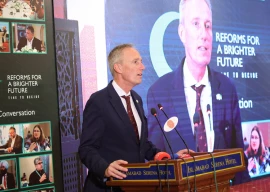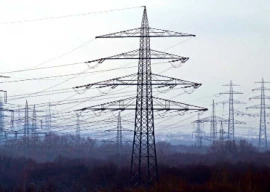
A recession scare is enveloping the topsy-turvy economy of the US as warning signs appear about its economic outlook in conjunction with the employment data. The global economy's great engine is faltering and sputtering gradually.
Data released by the US Department of Labour on August 21 showed that from April 2023 to March 2024, the number of new non-farm jobs in the United States decreased by 818,000.
The labour market indicators, prepared and published regularly, are considered important to understand the level of employment creation and destruction during a stipulated time period. This provides an opportunity not only for policymakers to design appropriate plans and policies to reach out to the vulnerable segments of the workforce but also researchers get a chance to study and analyse the trends.
Eminent economic analyst Zamir Ahmed Awan commented, "The US is a declining superpower."
The US economy is not as hot as the Biden-Harris (Joe Biden and Kamala Harris) administration is propagating. Former president Donald Trump reacted to the downward revision on his Truth Social account, dubbing it a "massive scandal" that shows the labour market is weaker than the Biden-Harris administration claims, New York Post reported.
The Russian Satellite News Agency said that the labour market is seen as the engine of the US economy's recovery from the Covid-19 pandemic and this revision highlights the fragility of the US labour market.
According to an Associated Press article, the revised data further proves that the US job market has been steadily slowing down and may strengthen the Fed's plan to start cutting interest rates soon.
The next monetary policy meeting of the Federal Reserve will be held on September 17 and 18, the latest data from the Chicago Mercantile Exchange's Federal Reserve Observation Tool reported recently.
Lately, there was some contradictory news as stock prices fell and then recovered amid decreasing US jobs. The American economy is falling prey to a slowdown but not a crash.
BBC News reported that Federal Reserve Chairman Jerome Powell (the head of the US central bank) has said "the time has come" for officials to cut interest rates, but he offered few clues as to how quickly or how far borrowing costs might come down.
The Fed undergoes a dilemma, if it reduces more, it may lead to some sort of a rise in inflation and if it decreases less, the growth may be weakened.
Senior economic analyst Dr Sabur Ghayur said, "This is, however, none of the area of concern for those sitting in policy and programme-making domains in countries like ours. In fact, we seldom bother about accurate and timely monitoring as well as reporting labour market trends. At times, cooking up figures isn't an unknown phenomenon in this part of the world."
Youth disillusionment and the disgruntled youth opting for illegal practices are not uncommon. Karachi is well known to demonstrate such a phenomenon. The worrying part is the law and order situation, which is deteriorating in other cosmopolitan cities including Islamabad, he said.
"This dismal situation is in stark contrast to not only in western countries but also in countries like Singapore."
Looking into the US labour market indicators, for instance, the situation set off alarm bells in the year 2010 when 14.83 million were reported to be unemployed. Latter years brought some normalcy.
However, owing to the Covid-19 pandemic, the number of unemployed swelled to 12.9 million in 2022. Did this trend continue? No! It's mainly attributed to the return of economic activities.
"The rise in the number of unemployed to 7.16 million in July 2024, in my opinion, will be continuously monitored and it is understood that besides the existing social safety nets, the labour market programmes are expected to be launched in case the numbers do not take a downward trend," he said.
The worrying part of the US labour market is the unemployed teenagers, those that are 16-19 years old, rising further from 11.3 million in 2023 to 12.4 million in the current year.
Those at the helm of affairs in Pakistan are urged to focus and monitor labour market trends on a regular basis to design appropriate mechanisms for minimising employment destruction and increasing job creation through tailoring suitable policy and programme responses.
The writer is a staff correspondent















1737618478-0/Express-Tribune---News-Desk-(9)1737618478-0-270x192.webp)








COMMENTS
Comments are moderated and generally will be posted if they are on-topic and not abusive.
For more information, please see our Comments FAQ